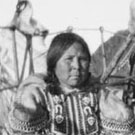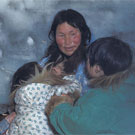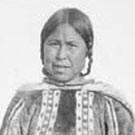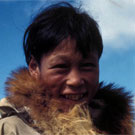Common menu bar links
Institutional links
Project Naming

photo collections
- Photographs from the North: Library and Archives Canada Collections
- Royal Canadian Mounted Police
- Geraldine Moodie photographs taken during the 1904-1905 Hudson Bay Expedition
- Department of Indian and Northern Affairs
- National Film Board of Canada
- Department of National Health and Welfare
- Private Collections
Private Collections
Private photographic collections that were digitized for the meetings between Nunavut youth and Elders
Richard Sterling Finnie
Richard Sterling Finnie (1906-1987) accompanied numerous expeditions to the North. His first voyage was aboard the CGS Arctic, under the command of Captain Bernier, in 1924. During the 1930-1931 expedition to the Western Arctic, Finnie filmed Dance of the Copper Eskimos. This collection contains photographs by Finnie as well as by other photographers.

Shappa, an employee of the Northwest Territories and Yukon Branch, Department of the Interior
Cape Dorset (Kinngait), 1929
PA-101392
Source
Charles Gimpel
Photographer and modern-art dealer Charles Gimpel (?-1973) pursued an interest in Inuit art that resulted in numerous trips to communities in the Baffin (Qikiqtaaluk) and Kivalliq (formerly Keewatin) regions from 1958 to 1969. The photographs in this collection, depicting Inuit artists and daily life, were taken by Gimpel, Bryan Pearson and Lorne Smith.

Dennis Okpik
and his mother, Rosie Okpik
Iqaluit (formerly Frobisher Bay), April 1964
e002394552
Source
William Harold Grant
First World War veteran William Harold Grant (1901-1980) served as secretary to J.D. Craig, the officer in charge of the Eastern Arctic expedition of 1922. The photographer of these images is unknown, but it is highly possible that they were taken by Grant.

Unidentified women and children with photographer William H. Grant
Unknown location, 1922
e002282912
Source
Donald Benjamin Marsh
Born in Middlesex, England, Donald Benjamin Marsh (1903-1973) arrived at Arviat (formerly Eskimo Point) at the age of 23 to set up an Anglican mission. In addition to his clerical duties, Marsh was also an amateur photographer and filmmaker. These photographs were all taken during his stay in Arviat during the mid-1930s.

Unidentified woman and children in their igloo
Arviat (formerly Eskimo Point) or possibly the Western Arctic, 1937
e002282596
Source
Kryn Taconis
Photojournalist Kryn Taconis (1918-1979) was born in Holland and emigrated to Toronto in 1959. He became a special contributor to major Canadian magazines, and also worked for the National Film Board of Canada for three years. Taconis's photographs digitized for Project Naming feature Inuit from Iqaluit (formerly Frobisher Bay) and Igloolik (Iglulik).
Arthur H. Tweedle
Optometrist and amateur photographer Arthur H. Tweedle (1900-1976) served on voyages sponsored by the Canadian Institute for the Blind aboard the RMS Nascopie in 1945 and again in 1946. During these trips, he kept a journal and took black and white photographs and colour slides of Inuit. So far, only the black and white photographs have been digitized for Project Naming.
















